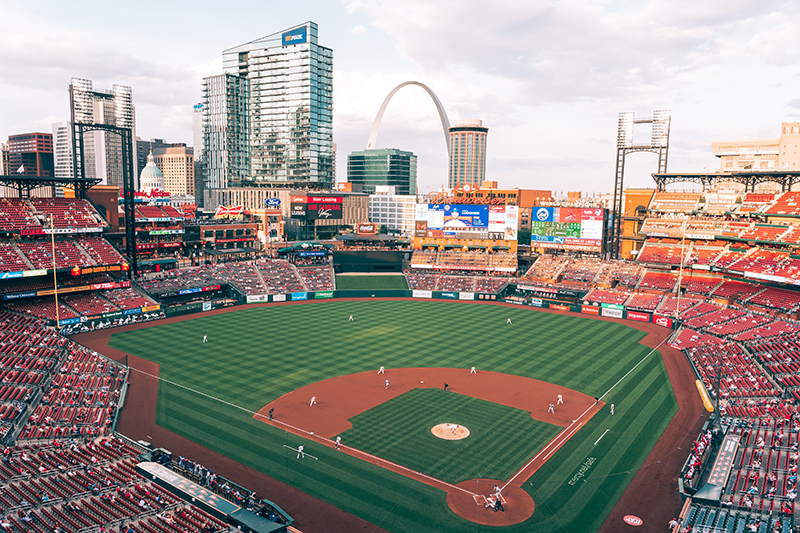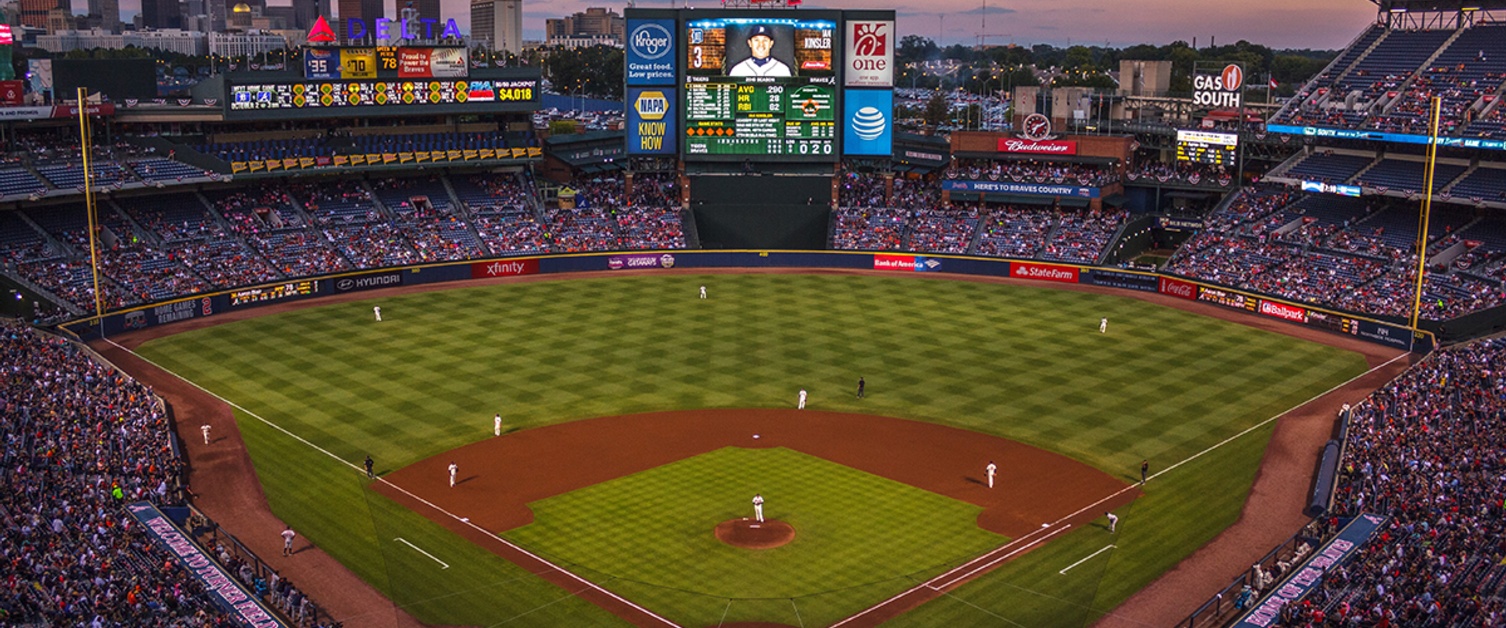Batter Up! How Higher Temperatures Impact Baseball Stats
- By Brandon Koch and Anna Panorska
- Jul 9, 2021
Photo by Joshua Peacock
Forget rain delays, temperature “is the most important meteorological variable affecting fly ball distances for MLB as a whole.” So concluded a 1995 study by Kraft and Skeeter that looked at temperature, humidity, and wind impacts on fly balls in Major League Baseball games. That study also found that batted fly balls in cool temperatures (at most 50°F) travel on average 16 ft less compared to warm temperatures (at least 90°F). Other examinations of the influence of temperature on home run frequencies in Atlanta, Georgia, found evidence that higher temperatures led to an increase in the number of home runs (Kingsley 1980).
But home runs are only one measure of an MLB game. So in order to learn the overall impact of temperature on baseball, and get our stats right, we have to broaden our view. Overall, it seems right that total offensive production might be higher in warmer temperatures than in colder temperatures. A baseball's coefficient of restitution (COR), which is the ratio of speeds after and before an impact, is lower with a cold baseball compared to a warm baseball (Drane and Sherwood 2004). This means that a baseball hit in lower temperatures might be colder and leave the bat at a lower speed than in higher temperatures.
Human reaction and movement time are also crucial elements in hitting a pitched baseball in a fraction of a second. And a decrease in body core temperature results in significantly slower reaction and movement time. This may mean that cold temperatures slow a hitter's reaction and movement time, thereby decreasing his performance in cold temperatures. So it certainly appears that cold temperature could negatively impact a hitter's performance, and decrease offensive production.
But let's take a look at how higher temperatures impact a wider array of MLB game statistics, including runs scored, batting average, slugging percentage, and walks.
Runs Scored
In an analysis of 22,000 games played in 23 stadiums, runs scored increased a significant amount from cold temperatures to warm temperatures. This was true for both the away batters and the home batters in both leagues. However, the American League shows much greater increases in runs scored than the National League. Away batters in the American League show a 21% increase in runs scored from cold to warm while the away batters in the National League show only a 7% increase in runs scored from cold to warm. Similar results hold for the home batters.
Batting Average
Batting average in both leagues shows significant increases from cold to warm for both the away and home batters. Similar to runs scored, the American League shows greater increases in batting average from cold to warm than the National League for both the away hitters (10% for the American League compared to 6% for the National League) and the home hitters (11% for the American League compared to 5% for the National League).
Across these 22,000 games, batting averages increased in 19 out of 23 stadiums (82.6%) for the home batters and in 20 out of 23 stadiums (87.0%) for the away batters. Eleven teams show significant increases in batting average from cold to warm at games played in their home stadiums. Eight ballparks show significant increases in batting average from cold to warm for the opposing batters. The home stadiums of the Baltimore Orioles, Chicago Cubs, Cincinnati Reds, Kansas City Royals, Pittsburgh Pirates, and San Francisco Giants show significant increases in batting average from cold to warm for both the home and away batters.

Home Runs
Another popular offensive statistic in Major League Baseball is the home run. As expected, home runs were strongly affected by temperature in this study. Both leagues showed significant increases in home runs from cold to warm for both the home and away batters. Again, the American League shows much larger increases in home runs from cold to warm than the National League. Away batters in the American League hit an average of 46% more home runs in warm temperatures compared to cold temperatures while away batters in the National League hit an average of 29% more home runs in warm temperatures. Similar results hold for the home batters.
A positive trend in home runs from cold to warm was noted in 22 out of 23 (95.7%) stadiums for the away batters and in 19 out of 23 stadiums (82.6%) for the home batters. The only stadium that showed a decrease in the number of home runs from cold to warm for the away batters was Angel Stadium of Anaheim, which showed a 0.003 decrease in home runs. This could be due to the small number of games played in warm temperatures at Angel Stadium (i.e., 22). Four stadiums showed significant increases in home runs for the home batters while nine stadiums showed significant increases in home runs for the away batters. Away batters in the Oakland Athletics stadium are hitting an average of 1.071 more home runs in games played in warm temperatures compared to cold temperatures, an increase of 138%. This could be due to the small number of games played in warm temperatures at Oakland's stadium.
Slugging Percentage
Slugging percentage is similar to batting average, but with more weight put on extra base hits, such as doubles, triples, and home runs. Because of this, slugging percentage is often considered a more efficient measure of offensive production than batting average as extra base hits often produce more runs than singles.
In both leagues, slugging percentage shows a significant increase from cold to warm for the away and home batters. Additionally, the increases in the American League are larger than those in the National League. Overall, 21 out of 23 stadiums (91.3%) show increases in slugging percentage from cold to warm for both the away batters and the home hitters. For the home hitters, five of these increases are significant, and for the away hitters, eight of the increases are significant.
Walks
In both leagues, walks show a decrease from cold to warm. Away batters show a significant decrease in walks in the National League from cold to warm, whereas American League away batters do not show a significant decrease in walks from cold to warm. Home batters show significant decreases in walks from cold to warm in both the American League and the National League, with the American League showing a larger average decrease. Overall, 19 out of 23 stadiums show a decrease in walks for both the home batters and the away batters. Six of those decreases are significant for the home batters while five are significant for the away batters. Home batters that show the most significant decrease in walks from cold to warm are those that play in Busch Stadium III, home of the St. Louis Cardinals, where walks decrease by 1.047 on average, a 24% decrease. The away batters that show the most significant decrease in walks from cold to warm are those that play at Citi Field, home of the New York Mets, where walks decrease by 1.788 on average, a 38% decrease.

More Statistics!
So what did we learn from all this? It appears that temperature has a formidable impact on the offense in a MLB game. Overall, offensive production tends to increase in warm weather as runs scored, batting average, slugging percentage, and home runs all show significant increases in games played in warm temperatures compared to cold temperatures. This can be explained by how temperature may impact a baseball's COR, human reaction time and movement, and a baseball's flight distance.
Interestingly, the American League shows a much stronger association between temperature and many offensive statistics—runs, home runs, batting average, and slugging percentage—than the National League, which might also suggest that the offense is impacted by temperature more than pitching and defense. This could be due to the presence of the designated hitter in American League lineups, and also because of the different offensive strategies that the two leagues use.
Sacrifice bunts are more widely used to manufacture runs in the National League than in the American League. For example, National League teams averaged 71.1 sacrifice bunts in the 2011 regular season, whereas American League teams only averaged 37.9 sacrifice bunts in the same season. Further, a National League team that needs to sacrifice their pitcher (or another batter) to score a run may not score as many runs in an inning as an American League team that allows the ninth hitter in the lineup (or another batter) to try to reach base without giving up an out. These reasons may explain why games played in the American League produced significantly more runs and home runs and had higher batting averages and slugging percentages per game than games played in the National League. Consequently, runs scored, home runs, batting average, and slugging percentage show a stronger dependence on temperature in the American League.
What About Walks?
Walks were the only statistic which tended to decrease as temperatures increase. We believe that this is due to the effect of cold weather on the pitcher. Our hands typically get dry in cold weather, and a pitcher with dry hands may not be able to get as good a grip on the baseball as a pitcher with nondry hands. This may result in reduced control and more walks. Even though pitchers use rosin bags to dry their hands in warm weather to help them grip the baseball, they also frequently blow into their hands and lick their fingers during cold weather, presumably to help them grip the ball. Since these acts provide moisture to the hand, it seems that dryness caused by cold weather negatively impacts a pitcher's grip.
Diminished pitching control in cold weather could also be caused by the effect of temperature on strength. Low muscle temperature reduces maximal strength in short-term exercises, like pitching. Consequently, cold temperature might decrease a pitcher's ability to grip a baseball. However, pitchers try to keep warm between innings during cold weather by wearing jackets or other warming devices on their pitching arms, so the effect of cold weather on a pitcher's muscular temperature is uncertain.
Game Impacts
While this information provides a lot more interesting statistics to add to our scorecards, it also could have some important implications for management. It may be beneficial for managers of MLB teams to take game-day temperature into account when setting their lineups. For instance, if a manager is having difficulty choosing between two players for his starting lineup, and one player is a more patient hitter and tends to draw more walks than the other player, the manager might benefit from starting the patient hitter in cold temperatures. Since batting average, slugging percentage, and home runs occur less frequently while walks occur more frequently in colder temperatures, a hitter may be more likely to reach base via a walk rather than with a hit on these days, possibly making a patient hitter more offensively efficient in cold temperatures.
Knowing that runs are less likely in cold temperatures, managers could use this knowledge to gain an advantage when making in-game decisions as well. For example, managers are often faced with a difficult decision of whether or not to sacrifice bunt in certain situations. Since a sacrifice bunt allows a player to move into scoring position while giving up an out, it is usually used to manufacture one run in an inning as a base hit after the sacrifice should score a run. The decision to not sacrifice bunt is usually made in hopes of earning a few hits in an inning and possibly scoring more than one run in the inning. Consequently, a manager may benefit from a sacrifice bunt during times when hits are less likely, as in cold temperatures, compared to times when hits are more likely, as in warm temperatures.
We'll have to watch a lot more games to keep increasing our sample size, but in the meantime it does appear that temperature is one of the most important meteorological factors for pitchers, batters, and managers.
This article has been edited and adapted specifically for the AMS Weather Band from an original article appearing in the journal Weather, Climate, and Society. Any errors and omissions may be attributed to AMS staff. Copyright remains with the AMS.
